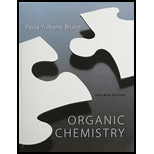
(a)
Interpretation:
3-bromocylohexene or bromocyclohexane reacts faster in E2/E1 reaction is to be identified.
Concept Introduction:
An E1 reaction is a two-step reaction in which the
Major product is more stable
An E2 reaction is a concerted, one-step reaction in which the proton is the more stable alkene, unless the reactants are sterically hindered or the leaving group is poor.
(b)
Interpretation:
3-bromocylohexene or bromocyclohexane reacts faster in E2/E1 reaction is to be identified.
Concept Introduction:
An E1 reaction is a two-step reaction in which the alkyl halide dissociates forming a carbocation intermediate. Then a base removes a proton from adjacent carbon to a positively charged carbon.
Major product is more stable alkene.
An E2 reaction is a concerted, one-step reaction in which the proton is the more stable alkene, unless the reactants are sterically hindered or the leaving group is poor.
Want to see the full answer?
Check out a sample textbook solution
Chapter 10 Solutions
Organic Chemistry & Study Guide and Student Solutions Manual for Organic Chemistry, Books a la Carte Edition (7th Edition)
- Which alkyl bromide will react the fastest in an E2 reaction?arrow_forwardRank the alkyl halides in each group in order of increasing reactivity in an E2 reaction.arrow_forwardConsider 3-iodo-2,3-dimethylpentane and 3-iodo-2methylpentane. a. which reacts faster in an Sn2 reaction? Explain. b. which reacts faster in an E2 reaction? Explain.arrow_forward
- Rank the following in order of reactivity in an E1 reaction, (1 = most reactive in an E1 reaction; 3 = least reactive in an E1 reaction).arrow_forwardRank these alkyl halides in order of increasing reactivity in an SN2 reactionarrow_forward(a) Which halide in the following marine natural product reacts fastest in the SN2 reaction? (b) Which halide in the following marine natural product reacts fastest in the SN1 reaction?arrow_forward
- Whats the reason for the girgnard reagent attack that carbon of starting point in this step? a. Bc it gives us desired product b. Due to the sterics c. Bc it is more electrophilic than the other carbon of the starting pointarrow_forwardWhich alkyl halide is more reactive in an SN2 reaction with a given nucleophile?arrow_forward
 Organic Chemistry: A Guided InquiryChemistryISBN:9780618974122Author:Andrei StraumanisPublisher:Cengage Learning
Organic Chemistry: A Guided InquiryChemistryISBN:9780618974122Author:Andrei StraumanisPublisher:Cengage Learning
